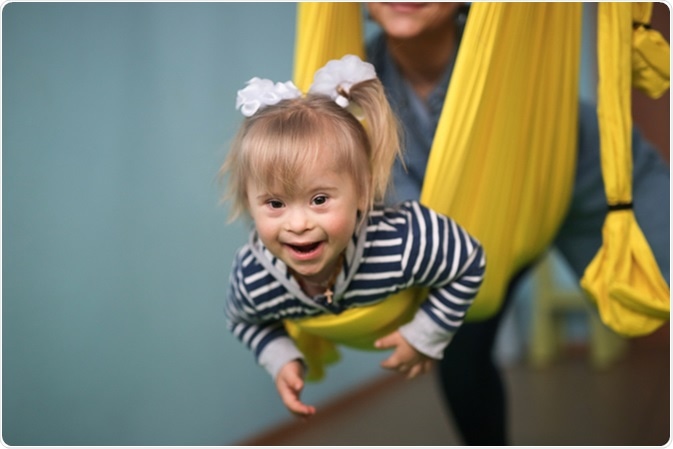Down Syndrome Symptoms
Down syndrome or Down's syndrome is a congenital condition that typically gives rise to characteristic physical features and a level of learning disability, which while common amongst those with Down’s, will vary between individuals in terms of appearance and severity.
Down’s syndrome is one of the most common chromosomal disorders, with approximately 6,000 babies per year born with the condition. The incidence rates are around 1 in every 700 babies, and between 1979 and 2003, the number of babies born with Down’s syndrome has increased by approximately 30%. Individuals with this condition may also suffer from a range of associated health problems, although the severity of these problems varies between individuals.

Diagnosis of Down’s Syndrome
Babies are often diagnosed with Down’s syndrome shortly after birth.
Symptoms present at birth include:
- Hypotonia (floppiness, feeling limp when held, displaying little or no control over the neck muscles, inability to place weight on leg or shoulder muscles)
- Below-average weight and length
- A flat back of the head
Down’s syndrome can be diagnosed during pregnancy through screening tests, which all pregnant women are offered. These screening tests for Down’s tell parents the likelihood of their baby having Down’s syndrome.
Chorionic villus sampling (CVS) is a test that can be carried out if previous screening tests indicate chances that a baby has Down’s syndrome. CVS tests a small sample of the placenta during weeks 11-14 of pregnancy. Amniocentesis is a test of the amniotic fluid, which is carried out during weeks 15-20 of pregnancy.
Counselling is offered to parents whose baby has Down’s syndrome so they are better able to understand and plan for the impact it will have on their child and everyday life.
Symptoms of Down’s Syndrome
Some of the signs and symptoms of Down’s syndrome include:
Upward slanting eyes with oblique fissures
- Unusually small chin (microgenia)
- Flat nasal bridge and small nose
- Small mouth
- Enlarged tongue (macroglossia)
- Broad head and a round face
- Single fold across the palm (called the palmar crease)
- Increased space between the first and second toe (called the sandal gap)
- Broad hands with short fingers
- Poor muscle tone
- Joint laxity.
Growth parameters including height, weight, and head circumference are smaller in children with Down’s syndrome.
Other symptoms include:
- Intellectual disability in most children with Down’s syndrome is mild (IQ 50 to 70) to moderate (IQ 35 to 50)
- Language skills and speech may be slow to develop, and reading and understanding are also delayed
- Development of fine motor skills may be delayed, as well as gross motor skills causing problems with sitting, standing, climbing and jumping
- Some children may also develop autism spectrum disorders or attention deficit hyperactivity disorder (ADHD)
Examples of severe conditions infants with Down’s syndrome may be at risk of include heart defects and intestinal abnormalities.
Complications Associated with Down’s Syndrome
The most common complication in children with Down’s syndrome is a septal defect, where there is a hole in one of the walls that separates the heart’s chambers. Gut problems are also common, including constipation, diarrhea and indigestion, and more serious issues including small bowel obstructions, celiac disease, reflux, imperforate anus, where there is no anal opening, and Hirschsprung’s disease, where the bowel is unable to move and push stool out. People with Down’s syndrome can also experience problems with their vision, hearing and thyroid, and can be more likely to develop infections and develop dementia at a younger age.
Risk Factors for Down’s Syndrome
Older mothers are more likely to have a baby with Down’s syndrome. Simply, the prevalence of Down’s syndrome increases with the mother’s age. For example, a 20-year-old woman has approximately 1 in 1,500 chance of having a baby with Down’s syndrome, and a 40-year-old woman has a 1 in 100 chance.
Measures taken before or during pregnancy demonstrate no evidence of affecting one’s chances of having a baby with Down’s syndrome. A woman’s chances of having a baby with Down’s syndrome is increased if she has previously had a baby with the condition, and there is a 1 in 2 chance of having a baby with Down’s syndrome if one of the parents also has the condition.
Prognosis
The life expectancy of people with Down’s syndrome has increased significantly. In 2007, it was estimated that on average people with Down’s syndrome would have a life expectancy of 47 years. There are a number of factors that can influence how long a person with Down’s syndrome lives, including:
- Low birth weight
- Black or African-American infants have a lower chance of surviving beyond their first year compared to white infants. More research is needed in this area to understand why.
- Additional congenital heart defects (CHDs). Around 50% of babies with Down’s syndrome also have a CHD at birth.
Overall, the death rate among babies with Down’s syndrome in their first year has decreased by around 40%, having stood at 1.5% during 1979-1983 and 0.9% during 1999-2003.
Sources
- http://www.dsmig.org.uk/pdf/downs3.pdf
- http://www.kcdsg.org/files/content/About%20Down%20Syndrome.pdf
- http://www.nbdpn.org/docs/DS_Eng.pdf
- http://www.nhs.uk/conditions/Downs-syndrome/Pages/Introduction.aspx
- https://www.cdc.gov/ncbddd/birthdefects/downsyndrome/data.html
- www.cdph.ca.gov/programs/CBDMP/Documents/MO-CBDMP-DownSyndrome.pdf
- www.ndss.org/…/…me%20A%20Health%20and%20Well-Being%20Guidebook.pdf
Further Reading
- All Down Syndrome Content
- Down Syndrome – What is Down Syndrome?
- Down Syndrome Complications
- Down Syndrome Screening
- Down Syndrome Management
Last Updated: Nov 14, 2018

Written by
Lois Zoppi
Lois is a freelance copywriter based in the UK. She graduated from the University of Sussex with a BA in Media Practice, having specialized in screenwriting. She maintains a focus on anxiety disorders and depression and aims to explore other areas of mental health including dissociative disorders such as maladaptive daydreaming.
Source: Read Full Article
